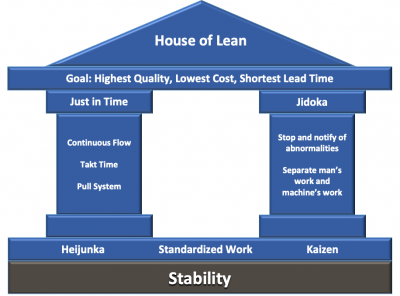Structured Problem Solving – The key to Lean?
We are all familiar with the “House of Lean”; with how the twin pillars of Just in Time (JIT) and Jidoka (built-in Quality) fundamentally drive profitability by increasing cashflow and reducing cost. That is why most Lean implementations focus on these two aspects.
However, Lean transformations frequently fail. Failure can be rooted in the fact that Lean is often reduced to the visible set of tools used to facilitate the implementation of the Lean concepts rather than imbedding the deeper Lean concepts themselves. All too often, the results of a Lean implementation are glossy Visual Management boards and Standardized Work cards. Return in six-months and the Visual Management boards have transformed into little-used notice boards and the standardized work cards are outdated and lining the bottom of a forgotten drawer.
Companies that have successfully implemented Lean understand that the “Stability” or foundation the House of Lean is built upon is Structured Problem Solving. The iterative improvement loop offered by Structured Problem Solving allows for the correct Lean tools to be used at the correct time and in the correct way.
Despite this, Structured Problem Solving is underutilized and laboratories are especially slow to embrace it.
So, what is Structured Problem Solving? Toyota defines the following 8-steps:
- Clarify the Problem
- Breakdown the Problem
- Set the Target
- Analyze the Root Cause
- Develop Countermeasures
- Implement Countermeasures
- Monitor Results and Process
- Standardize and Share Success
The irony is that most laboratories will be using a similar set of steps (or a sub-set) everyday as part of their deviation process. So why the resistance to applying Structured Problem Solving to their business processes?
I would argue that the underutilization of the 8-step process is analogous to why Lean implementations all too often fail. A focus and reliance on the tools with a lack of understanding of the core foundations that guide their use. The power and efficacy of 8-step problem solving lies not in the use of root cause analysis tools – the Ishikawa diagrams or the 5-whys – to develop and implement counter measures. Rather, it lies in the first three steps – to develop a shared, concise understanding of the problem and more importantly, alignment on what would be considered solving it.
Unfortunately, these first, critical steps are often rushed or neglected entirely. Whether due to the flawed assumption that everyone’s understanding of the problem is the same (it very rarely is), a lack of time or resources available to collect the necessary data, or an enthusiastic team who want to launch directly into the root cause analysis, the end result is often the same; ineffective, box ticking CAPAs that fail to address the underlying issue.
BSM’s methodology inherently supports good Structured Problem Solving. The visual management systems developed as part of our Lean Lab implementations allow the perfect framework to facilitate the 8-steps. The use of Short Interval Control and properly developed KPI’s ensure that first three steps are easy to complete as the data and targets are readily available, while also serving as triggers themselves. As such a complete Lean Lab solution will make it easy to identify when failures are occurring and will provide the information to support Structured Problem Solving. Also, as Lean Lab solutions are developed and owned by lab members the process can help embolden the lab to tackle and solve the problems they face.
Our consultants can provide further information on the above and discuss any aspect of Real Lean Transformation, simply set-up a call today.


